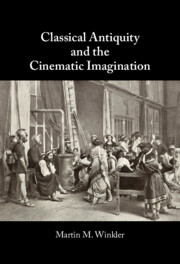364 results
26 - LGBT Bestsellers
- from Queer Genre
-
-
- Book:
- The Cambridge History of Queer American Literature
- Published online:
- 17 May 2024
- Print publication:
- 06 June 2024, pp 455-469
-
- Chapter
- Export citation
Introduction
-
-
- Book:
- The Cambridge History of Queer American Literature
- Published online:
- 17 May 2024
- Print publication:
- 06 June 2024, pp 1-30
-
- Chapter
- Export citation
Chapter 30 - America
- from Part V - World Cultures Inspiration and Reception
-
-
- Book:
- Goethe in Context
- Published online:
- 16 May 2024
- Print publication:
- 23 May 2024, pp 291-300
-
- Chapter
- Export citation
Chapter 24 - Geology
- from Part IV - Philosophy and Science
-
-
- Book:
- Goethe in Context
- Published online:
- 16 May 2024
- Print publication:
- 23 May 2024, pp 234-242
-
- Chapter
- Export citation
Chapter 29 - China
- from Part V - World Cultures Inspiration and Reception
-
-
- Book:
- Goethe in Context
- Published online:
- 16 May 2024
- Print publication:
- 23 May 2024, pp 282-290
-
- Chapter
- Export citation
7 - Framing the Freed Person
-
-
- Book:
- Freed Persons in the Roman World
- Published online:
- 16 May 2024
- Print publication:
- 23 May 2024, pp 189-216
-
- Chapter
- Export citation
Chapter 1 - Playwrights
- from Part I - Theatre Makers
-
-
- Book:
- The Cambridge Companion to British Theatre since 1945
- Published online:
- 14 March 2024
- Print publication:
- 21 March 2024, pp 23-41
-
- Chapter
- Export citation
‘A sad inheritance of misery’: the cultural life of hereditary scrofula in eighteenth-century England
-
- Journal:
- Medical History / Volume 68 / Issue 1 / January 2024
- Published online by Cambridge University Press:
- 15 March 2024, pp. 1-21
-
- Article
-
- You have access
- Open access
- HTML
- Export citation
The Postcolonial Uncanny in “Toba Tek Singh”
-
- Journal:
- Cambridge Journal of Postcolonial Literary Inquiry / Volume 11 / Issue 1 / January 2024
- Published online by Cambridge University Press:
- 04 March 2024, pp. 66-73
-
- Article
-
- You have access
- Open access
- HTML
- Export citation
3 - Fragmenting Frauenliebe und -leben
-
-
- Book:
- The Lied at the Crossroads of Performance and Musicology
- Published online:
- 09 February 2024
- Print publication:
- 15 February 2024, pp 55-77
-
- Chapter
- Export citation

Classical Antiquity and the Cinematic Imagination
-
- Published online:
- 15 February 2024
- Print publication:
- 22 February 2024
6 - Resilience
-
- Book:
- A Concise History of the Aztecs
- Published online:
- 08 February 2024
- Print publication:
- 15 February 2024, pp 202-245
-
- Chapter
- Export citation
Chapter 2 - Colonial Untranslatables
- from Part I - Epistemic Habits
-
- Book:
- Colonialism, World Literature, and the Making of the Modern Culture of Letters
- Published online:
- 19 January 2024
- Print publication:
- 08 February 2024, pp 82-116
-
- Chapter
- Export citation
16 - Keynes, The Economic Consequences of the Peace, and Popular Perceptions of the First World War
-
-
- Book:
- Keynes's <i>Economic Consequences of the Peace</i> after 100 Years
- Published online:
- 14 December 2023
- Print publication:
- 25 January 2024, pp 421-442
-
- Chapter
- Export citation
Chapter 11 - Time and Narrative in the Age of Postnatural Death
- from Part II - Developments: Forms
-
-
- Book:
- Literature and Medicine
- Published online:
- 17 January 2024
- Print publication:
- 18 January 2024, pp 186-203
-
- Chapter
- Export citation
Chapter 13 - The Parallel Chart as Medico-Literary Practice
- from Part II - Developments: Forms
-
-
- Book:
- Literature and Medicine
- Published online:
- 17 January 2024
- Print publication:
- 18 January 2024, pp 221-237
-
- Chapter
- Export citation
Chapter 5 - Embodied Traumas in Twentieth- and Twenty-First-Century Literature
- from Part I - Origins: Histories
-
-
- Book:
- Literature and Medicine
- Published online:
- 17 January 2024
- Print publication:
- 18 January 2024, pp 85-102
-
- Chapter
- Export citation
Un-suturing Westphalian IR via non-Western literature: A Grey Man (1963)
-
- Journal:
- Review of International Studies , First View
- Published online by Cambridge University Press:
- 04 January 2024, pp. 1-19
-
- Article
- Export citation
“Like Home”: Gerrymandering the Physical Public Sphere in Female Journalist Narratives
-
- Journal:
- The Journal of the Gilded Age and Progressive Era / Volume 23 / Issue 1 / January 2024
- Published online by Cambridge University Press:
- 16 April 2024, pp. 84-101
- Print publication:
- January 2024
-
- Article
- Export citation
Introduction: On Literature
-
- Journal:
- The Journal of the Gilded Age and Progressive Era / Volume 23 / Issue 1 / January 2024
- Published online by Cambridge University Press:
- 16 April 2024, pp. 3-8
- Print publication:
- January 2024
-
- Article
- Export citation



